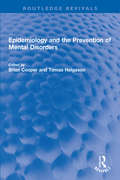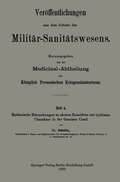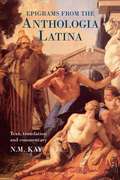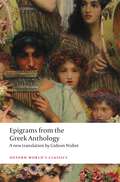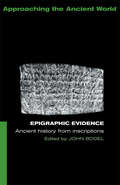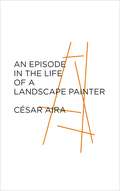- Table View
- List View
Epidemics and War: The Impact of Disease on Major Conflicts in History
by Rebecca M. SeamanThrough its coverage of 19 epidemics associated with a broad range of wars, and blending medical knowledge, demographics, geographic, and medical information with historical and military insights, this book reveals the complex relationship between epidemics and wars throughout history.How did small pox have a tremendous effect on two distinct periods of war—one in which the disease devastated entire native armies and leadership, and the other in which technological advancements and the application of medical knowledge concerning the disease preserved an army and as a result changed the course of events? Epidemics and War: The Impact of Disease on Major Conflicts in History examines fascinating historical questions like this and dozens more, exploring a plethora of communicable diseases—viral, fungal, and/or bacterial in nature—that spread and impacted wars or were spread by some aspect of mass human conflict.Written by historians, medical doctors, and people with military backgrounds, the book presents a variety of viewpoints and research approaches. Each chapter examines an epidemic in relation to a period of war, demonstrating how the two impacted each other and affected the populations involved directly and indirectly. Starting with three still unknown/unidentified epidemics (ranging from Classical Athens to the Battle of Bosworth in England), the book's chapters explore a plethora of diseases that spread through wars or significantly impacted wars. The book also examines how long-ended wars can play a role in the spread of epidemics a generation later, as seen in the 21st-century mumps epidemic in Bosnia, 15 to 20 years after the Bosnian conflicts of the 1990s.
Epidemien und Pandemien in historischer Perspektive: Epidemics and Pandemics in Historical Perspective (Edition Centaurus – Neuere Medizin- und Wissenschaftsgeschichte)
Im Zentrum dieses Sammelbandes stehen neue Forschungsergebnisse interdisziplinärer Autorinnen und Autoren aus sieben Ländern zum Thema Seuchen. Seuchen verbreiten zunächst Unsicherheiten, so dass historische Beispiele und Denkweisen herangezogen werden, um Gefahren zu erkennen und Gegenmaßnahmen zu treffen. Solche Traditionen lassen sich über Jahrhunderte zurück verfolgen. So werden in diesem Band die Rekonstruktion von Fakten in Zeit und Raum (global vs. local) sowie die Einflüsse auf das Kulturleben (cultural impact) und die der Wissenschaftsgeschichte (Science studies) analysiert. Einführend und abschließend werden Forschungsstand und -perspektiven zur Sozialgeschichte der Medizin diskutiert.
An Epidemiological Odyssey: The Evolution of Communicable Disease Control
by George PollockThis book attempts to set communicable diseases and the efforts to control them in a social and historical context. The primary focus is on England with its particular history, culture and traditions. The timescale covered is extensive and ambitious, and the many strands that came together in the nineteenth century to form the English public health service are clearly highlighted. However the main emphasis of the narrative is on developments from the Second World War onwards, in some of which the author has had a degree of personal involvement as a schoolchild, medical student, hospital doctor, Army doctor and public health physician.The work as a whole reveals the persisting nature of communicable diseases throughout history and strongly argues that, although the relevant importance of individual infections may vary over time, man’s struggle against the microbiological world can never be relaxed. How England has been affected is described in detail and evidence is put forward to suggest that complacency (or at least misjudgement) concerning the ever-present risks of emerging and re-emerging infections, led unwisely to the dismantling in 1974 of its established arrangements for their control, along with the subsequent need, frequently repeated, to create new structures for this purpose. This book will appeal strongly to all students and practitioners of public health along with those interested in English social history.
Epidemiology and the Prevention of Mental Disorders (Routledge Revivals)
by Brian Cooper To 769 Mas HelgasonFirst published in 1989, Epidemiology and the Prevention of Mental Disorders examines the research undertaken into the methods for studying the occurrence of mental illness in populations during the twenty years prior to publication. The book explores the incidence and distribution of conditions such as schizophrenia, depression, alcoholism, addiction, and dementia across populations, and the risk factors with which they are associated. Taking a public health approach to the prevention of mental illness, the book reports on epidemiological research in psychiatry, emphasising its use in preventative terms, and making connections between its use in psychiatry and its use in other fields of medicine. It also comments on the development of psychiatric epidemiology as a public health discipline and draws attention to the implications of contemporary changes to biological and social environments on mental health. Epidemiology and the Prevention of Mental Disorders will appeal to those with an interest in the history of psychiatric epidemiology and mental health.
Epidemiology and the Prevention of Mental Disorders (Routledge Revivals)
by Brian Cooper To 769 Mas HelgasonFirst published in 1989, Epidemiology and the Prevention of Mental Disorders examines the research undertaken into the methods for studying the occurrence of mental illness in populations during the twenty years prior to publication. The book explores the incidence and distribution of conditions such as schizophrenia, depression, alcoholism, addiction, and dementia across populations, and the risk factors with which they are associated. Taking a public health approach to the prevention of mental illness, the book reports on epidemiological research in psychiatry, emphasising its use in preventative terms, and making connections between its use in psychiatry and its use in other fields of medicine. It also comments on the development of psychiatric epidemiology as a public health discipline and draws attention to the implications of contemporary changes to biological and social environments on mental health. Epidemiology and the Prevention of Mental Disorders will appeal to those with an interest in the history of psychiatric epidemiology and mental health.
Epidemische Erkrankungen an akutem Exanthem mit typhösem Charakter in der Garnison Cosel (Veröffentlichungen aus dem Gebiete des Militär-Sanitätswesens)
by Franz Bernhard SchulteThe epigram in England, 1590–1640
by James DoelmanWhile among the most common of Renaissance genres, the epigram has been largely neglected by scholars and critics: James Doelman's book is the first major study on the Renaissance English epigram since 1947. It combines thorough description of the genre's history and conventions with consideration of the rootedness of individual epigrams within specific social, political and religious contexts. The book explores questions of libel, censorship and patronage associated with the genre, and includes chapters on the sub-genres of the religious epigram, political epigram and mock epitaph. It balances discussion of canonical figures such as Ben Jonson and Sir John Harington with a wide range of lesser known poets, drawing on both manuscript and print sources. In its breadth The epigram in England serves as a foundational introduction to the genre for students, and through its detailed case studies it offers rich analysis for advanced scholars.
The epigram in England, 1590–1640 (PDF)
by James DoelmanWhile among the most common of Renaissance genres, the epigram has been largely neglected by scholars and critics: James Doelman's book is the first major study on the Renaissance English epigram since 1947. It combines thorough description of the genre's history and conventions with consideration of the rootedness of individual epigrams within specific social, political and religious contexts. The book explores questions of libel, censorship and patronage associated with the genre, and includes chapters on the sub-genres of the religious epigram, political epigram and mock epitaph. It balances discussion of canonical figures such as Ben Jonson and Sir John Harington with a wide range of lesser known poets, drawing on both manuscript and print sources. In its breadth The epigram in England serves as a foundational introduction to the genre for students, and through its detailed case studies it offers rich analysis for advanced scholars.
Epigrams: With parallel Latin text (Oxford World's Classics)
by Martial'If you're one of those terribly serious readers, now is a good time to leave.' The poet we call Martial, Marcus Valerius Martialis, lived by his wits in first-century Rome. Pounding the mean streets of the Empire's capital, he takes apart the pretensions, addictions, and cruelties of its inhabitants with perfect comic timing and killer punchlines. Social climbers and sex-offenders, rogue traders and two-faced preachers - all are subject to his forensic annihilations and often foul-mouthed verses. Packed with incident and detail, Martial's epigrams bring Rome vividly to life in all its variety; biting satire rubs alongside tender friendship, lust for life beside sorrow for loss. Gossipy, clever, and above all entertaining, they express amusement as much as indignation at the vices they expose. This selection brings Martial to a twenty-first century readership in a prose translation that pulls no punches and presents him in all his moods. It establishes his originality as a literary author, and the significance of his achievement as the poet who conquered epigram for Rome. ABOUT THE SERIES: For over 100 years Oxford World's Classics has made available the widest range of literature from around the globe. Each affordable volume reflects Oxford's commitment to scholarship, providing the most accurate text plus a wealth of other valuable features, including expert introductions by leading authorities, helpful notes to clarify the text, up-to-date bibliographies for further study, and much more.
Epigrams from the Anthologia Latina: Text,Translation and Commentary
by N. M. KayThis new scholarly edition consists of the Latin text, with translation and detailed commentary, of a sequence of epigrams from the Anthologia Latina (Shackleton Bailey 78-188). The introduction discusses whether these epigrams constitute a unified collection and are the work of a single author, examines their likely date and place of composition – which, it is argued, is North Africa under Vandal rule –, and sets them in their cultural context. The line-by-line commentary covers issues of literary, linguistic and historical significance. Although text and interpretation of these pieces present frequent difficulties, the author confirms that they make up a fascinating collection of considerable importance and merit, contrary to the low reputation generally associated with the Anthologia Latina. The book will be of great interest to students of Latin literature and language in general, the epigram tradition in particular, and the culture of Vandal Africa.
Epigrams from the Anthologia Latina: Text,Translation and Commentary
by N. M. KayThis new scholarly edition consists of the Latin text, with translation and detailed commentary, of a sequence of epigrams from the Anthologia Latina (Shackleton Bailey 78-188). The introduction discusses whether these epigrams constitute a unified collection and are the work of a single author, examines their likely date and place of composition – which, it is argued, is North Africa under Vandal rule –, and sets them in their cultural context. The line-by-line commentary covers issues of literary, linguistic and historical significance. Although text and interpretation of these pieces present frequent difficulties, the author confirms that they make up a fascinating collection of considerable importance and merit, contrary to the low reputation generally associated with the Anthologia Latina. The book will be of great interest to students of Latin literature and language in general, the epigram tradition in particular, and the culture of Vandal Africa.
Epigrams from the Greek Anthology (Oxford World's Classics)
by Gideon NisbetLush Diodorus sets the lads on fire, But now another has him in his net - Timarion, the boy with wanton eyes . . . Meleager, AP 12.109 Encompassing four thousand short poems and more, the ramshackle classic we call the Greek Anthology gathers up a millennium of snapshots from ancient daily life. Its influence echoes not merely in the classic tradition of the English epigram (Pope, Dryden) but in Rudyard Kipling, Ezra Pound, Virgina Woolf, T. S. Eliot, H.D., and the poets of the First World War. Its variety is almost infinite. Victorious armies, ruined cities, and Olympic champions share space with lovers' quarrels and laments for the untimely dead - but also with jokes and riddles, art appreciation, potted biographies of authors, and scenes from country life and the workplace. This selection of more than 600 epigrams in verse is the first major translation from the Greek Anthology in nearly a century. Each of the Anthology's books of epigrams is represented here, in manuscript order, and with extensive notes on the history and myth that lie behind them.
Epigrams from the Greek Anthology (Oxford World's Classics)
by Gideon NisbetLush Diodorus sets the lads on fire, But now another has him in his net - Timarion, the boy with wanton eyes . . . Meleager, AP 12.109 Encompassing four thousand short poems and more, the ramshackle classic we call the Greek Anthology gathers up a millennium of snapshots from ancient daily life. Its influence echoes not merely in the classic tradition of the English epigram (Pope, Dryden) but in Rudyard Kipling, Ezra Pound, Virgina Woolf, T. S. Eliot, H.D., and the poets of the First World War. Its variety is almost infinite. Victorious armies, ruined cities, and Olympic champions share space with lovers' quarrels and laments for the untimely dead - but also with jokes and riddles, art appreciation, potted biographies of authors, and scenes from country life and the workplace. This selection of more than 600 epigrams in verse is the first major translation from the Greek Anthology in nearly a century. Each of the Anthology's books of epigrams is represented here, in manuscript order, and with extensive notes on the history and myth that lie behind them.
The Epigrams of Philodemos: Introduction, Text, and Commentary
by David SiderThis edition collects all the epigrams attributed to Epicurean philosopher and poet Philodemos of Gadara (ca. 110-40 BC). In editing these epigrams, Sider has reexamined several manuscripts of the Greek Anthology. Thirty-eight epigrams (three only doubtfully Philodemean, and two spurious) are printed in the original Greek and in English translation, with full critical apparatus and commentary. Sider also includes the text of a recently edited papyrus containing fragments of many known and newly discovered epigrams by Philodemos. In addition to the usual issues involved in editing a Classical poet--i.e. the poet's life, his use of meter, the epigrammatic tradition, and the place of the epigrams in the Greek Anthology--Sider's introduction considers the relationship between Philodemos' philosophy and poetry. He explains how the epigrams fit into the literary views expressed in Philodemos' On Poems and how they clashed with the Epicurean stance against the writing of poetry.
Epigraphic Evidence: Ancient History From Inscriptions (Approaching the Ancient World)
by John BodelEpigraphic Evidence is an accessible guide to the responsible use of Greek and Latin inscriptions as sources for ancient history. It introduces the types of historical information supplied by inscriptional texts and the methods with which they can be used. It outlines the limitations as well as the advantages of the different types of evidence covered. Epigraphic Evidence includes a general introduction, a guide to the arrangement of the standard corpora inscriptions and individual chapters on local languages and native cultures, epitaphs and the ancient economy amongst others.
Epigraphic Evidence: Ancient History From Inscriptions (Approaching the Ancient World)
by John BodelEpigraphic Evidence is an accessible guide to the responsible use of Greek and Latin inscriptions as sources for ancient history. It introduces the types of historical information supplied by inscriptional texts and the methods with which they can be used. It outlines the limitations as well as the advantages of the different types of evidence covered. Epigraphic Evidence includes a general introduction, a guide to the arrangement of the standard corpora inscriptions and individual chapters on local languages and native cultures, epitaphs and the ancient economy amongst others.
The Epigraphy of Ptolemaic Egypt (Oxford Studies in Ancient Documents)
by Alan Bowman Charles CrowtherThe Ptolemaic period in Egypt (332-30 BC) is one of the most well-documented periods of the Hellenistic age: in addition to the papyrological record there are more than 600 surviving Greek and Greek/Egyptian bilingual and trilingual inscriptions, ranging from massive public monuments, such as the Rosetta Stone, to small private dedications, funerary plaques, and metrical epigrams for the deceased. This volume offers a series of detailed studies of the historical and cultural contexts of these important inscriptions and is intended to complement the multi-volume Corpus of Ptolemaic Inscriptions edition, in which the Greek and Egyptian texts will be presented together for the first time. The subjects discussed in the twelve chapters range widely across a variety of sub-disciplines, from advances in new technologies of image-capture, the juxtaposition of Greek and Egyptian elements in the layout and iconography of the monuments, and the palaeography of the Greek texts, to the history of the acquisition and study of the great bilingual decrees voted by the priests of the indigenous Egyptian cults, the introduction of Greek civic administration and communal associations in the cities and villages, and the role of the military in monumental commemoration. Particular attention is given to the role of indigenous and Greek religious institutions in Alexandria and the towns and villages of the Nile Delta and Valley, in which commemorative dedications to divinities of temples and statues by the monarchs and by private individuals are numerous and prominent. In a period shaped by the interplay between Egyptian and Greek culture, the existence of public and private inscribed monuments was a vital element of dynastic control. The unique insights offered by this thorough examination of the epigraphical landscape of Ptolemaic Egypt are invaluable to understanding the ways in which the Greek immigrant rulers and population established and reinforced their social and cultural dominance of an indigenous population which had its own long-established and traditional written and iconographic mode of public and private communication.
The Epigraphy of Ptolemaic Egypt (Oxford Studies in Ancient Documents)
The Ptolemaic period in Egypt (332-30 BC) is one of the most well-documented periods of the Hellenistic age: in addition to the papyrological record there are more than 600 surviving Greek and Greek/Egyptian bilingual and trilingual inscriptions, ranging from massive public monuments, such as the Rosetta Stone, to small private dedications, funerary plaques, and metrical epigrams for the deceased. This volume offers a series of detailed studies of the historical and cultural contexts of these important inscriptions and is intended to complement the multi-volume Corpus of Ptolemaic Inscriptions edition, in which the Greek and Egyptian texts will be presented together for the first time. The subjects discussed in the twelve chapters range widely across a variety of sub-disciplines, from advances in new technologies of image-capture, the juxtaposition of Greek and Egyptian elements in the layout and iconography of the monuments, and the palaeography of the Greek texts, to the history of the acquisition and study of the great bilingual decrees voted by the priests of the indigenous Egyptian cults, the introduction of Greek civic administration and communal associations in the cities and villages, and the role of the military in monumental commemoration. Particular attention is given to the role of indigenous and Greek religious institutions in Alexandria and the towns and villages of the Nile Delta and Valley, in which commemorative dedications to divinities of temples and statues by the monarchs and by private individuals are numerous and prominent. In a period shaped by the interplay between Egyptian and Greek culture, the existence of public and private inscribed monuments was a vital element of dynastic control. The unique insights offered by this thorough examination of the epigraphical landscape of Ptolemaic Egypt are invaluable to understanding the ways in which the Greek immigrant rulers and population established and reinforced their social and cultural dominance of an indigenous population which had its own long-established and traditional written and iconographic mode of public and private communication.
Epiphany in the Wilderness: Hunting, Nature, and Performance in the Nineteenth-Century American West
by Karen R. JonesWhether fulfilling subsistence needs or featured in stories of grand adventure, hunting loomed large in the material and the imagined landscape of the nineteenth-century West. Epiphany in the Wilderness explores the social, political, economic, and environmental dynamics of hunting on the frontier in three “acts,” using performance as a trail guide and focusing on the production of a “cultural ecology of the chase” in literature, art, photography, and taxidermy. Using the metaphor of the theater, Jones argues that the West was a crucial stage that framed the performance of the American character as an independent, resourceful, resilient, and rugged individual. The leading actor was the all-conquering masculine hunter hero, the sharpshooting man of the wilderness who tamed and claimed the West with each provident step. Women were also a significant part of the story, treading the game trails as plucky adventurers and resilient homesteaders and acting out their exploits in autobiographical accounts and stage shows. Epiphany in the Wilderness informs various academic debates surrounding the frontier period, including the construction of nature as a site of personal challenge, gun culture, gender adaptations and the crafting of the masculine wilderness hero figure, wildlife management and consumption, memorializing and trophy-taking, and the juxtaposition of a closing frontier with an emerging conservation movement. The University Press of Colorado gratefully acknowledges the generous support of the Charles Redd Center for Western Studies at Brigham Young University toward the publication of this book.
Episcopal Appointments in England, c. 1214–1344: From Episcopal Election to Papal Provision (Church, Faith and Culture in the Medieval West)
by Katherine HarveyIn 1214, King John issued a charter granting freedom of election to the English Church; henceforth, cathedral chapters were, theoretically, to be allowed to elect their own bishops, with minimal intervention by the crown. Innocent III confirmed this charter and, in the following year, the right to electoral freedom was restated at the Fourth Lateran Council. In consequence, under Henry III and Edward I the English Church enjoyed something of a golden age of electoral freedom, during which the king might influence elections, but ultimately could not control them. Then, during the reigns of Edward II and Edward III, papal control over appointments was increasingly asserted and from 1344 onwards all English bishops were provided by the pope. This book considers the theory and practice of free canonical election in its heyday under Henry III and Edward I, and the nature of and reasons for the subsequent transition to papal provision. An analysis of the theoretical evidence for this subject (including canon law, royal pronouncements and Lawrence of Somercote’s remarkable 1254 tract on episcopal elections) is combined with a consideration of the means by which bishops were created during the reigns of Henry III and the three Edwards. The changing roles of the various participants in the appointment process (including, but not limited to, the cathedral chapter, the king, the papacy, the archbishop and the candidate) are given particular emphasis. In addition, the English situation is placed within a European context, through a comparison of English episcopal appointments with those made in France, Scotland and Italy. Bishops were central figures in medieval society and the circumstances of their appointments are of great historical importance. As episcopal appointments were also touchstones of secular-ecclesiastical relations, this book therefore has significant implications for our understanding of church-state interactions during the thirteenth and fourteenth centu
Episcopal Appointments in England, c. 1214–1344: From Episcopal Election to Papal Provision (Church, Faith and Culture in the Medieval West)
by Katherine HarveyIn 1214, King John issued a charter granting freedom of election to the English Church; henceforth, cathedral chapters were, theoretically, to be allowed to elect their own bishops, with minimal intervention by the crown. Innocent III confirmed this charter and, in the following year, the right to electoral freedom was restated at the Fourth Lateran Council. In consequence, under Henry III and Edward I the English Church enjoyed something of a golden age of electoral freedom, during which the king might influence elections, but ultimately could not control them. Then, during the reigns of Edward II and Edward III, papal control over appointments was increasingly asserted and from 1344 onwards all English bishops were provided by the pope. This book considers the theory and practice of free canonical election in its heyday under Henry III and Edward I, and the nature of and reasons for the subsequent transition to papal provision. An analysis of the theoretical evidence for this subject (including canon law, royal pronouncements and Lawrence of Somercote’s remarkable 1254 tract on episcopal elections) is combined with a consideration of the means by which bishops were created during the reigns of Henry III and the three Edwards. The changing roles of the various participants in the appointment process (including, but not limited to, the cathedral chapter, the king, the papacy, the archbishop and the candidate) are given particular emphasis. In addition, the English situation is placed within a European context, through a comparison of English episcopal appointments with those made in France, Scotland and Italy. Bishops were central figures in medieval society and the circumstances of their appointments are of great historical importance. As episcopal appointments were also touchstones of secular-ecclesiastical relations, this book therefore has significant implications for our understanding of church-state interactions during the thirteenth and fourteenth centu
The Episode At Toledo: A Julia Probyn Mystery, Book 6 (The Julia Probyn Mysteries)
by Ann BridgeIn the beautiful countryside of Portugal, erstwhile British secret agent Julia Probyn is to attend a royal wedding. But her former acquaintance, Countess Hetta Páloczy, the young Hungarian refugee, unwittingly gets them both tangled in Cold War intrigue. After Hetta accidentally uncovers a Communist plot to assassinate an American admiral in Spain, she is a marked woman yet again and must flee to Portugal. But even in the tranquil beauty of Gralheira, peril lurks. Unluckily for the assassins, these women are no strangers to danger.In The Episode at Toledo, book six in the series, Julia is joined by Hetta and Luzia, uniting all our heroines from The Julia Probyn Mysteries.
An Episode in the Life of a Landscape Painter
by César Aira Chris AndrewsCesar Aira's An Episode in the Life of a Landscape Painter captures a moment in the life of the German artist Johann Moritz Rugendas. Greatly admired as a master landscape painter, he was advised by Alexander von Humboldt to record the spectacular landscapes of Chile, Argentina and Mexico. Rugendas did in fact become one of the best nineteenth-century European painters to venture into Latin America. However, this is not a biography of Rugendas, but rather a work of fiction which weaves an almost surreal history around Rugendas' trips to Argentina where he strived to achieve in art the 'physiognomic totality' of Humboldt's scientific vision of the whole. A brief and dramatic visit to the pampas gives him the chance to fulfill his ambition but a strange episode that he cannot avoid absorbing savagely into his own body interrupts the trip and irreversibly marks him for life . . .Praise for Cesar Aira:'Once you've started reading Aira, you don't want to stop' Roberto Bolaño'Aira is firmly in the tradition of Jorge Luis Borges and W. G. Sebald' Los Angeles TimesCesar Aira was born in Coronel Pringles, Argentina, in 1949, and has lived in Buenos Aires since 1967. One of the most prolific writers in Argentina, Aira has published more than seventy books.
Episodes from the History of the Rare Earth Elements (Chemists and Chemistry #15)
by C. H. Evans3. 4. 2. "SOMETHING ON CERIUM . . . . . . . . . . . . . . . . . . . . . . . . . . . . . . . . . . . . . . . . . . . . . . . . . . . . . . . . . . . . . . . 41 3. 4. 3. THE DISCOVERY OF LANTHANUM . . . . . . . . . . . . . . . . . . . . . . . . . . . . . . . . . . . . . . . . . . . . . . . . 42 3. 4. 4. THE DISCOVERY OF DIDYMIUM . . . . . . . . . . . . . . . . . . . . . . . . . . . . . . . . . . . . . . . . . . . . . . . . . . . . 45 3. 4. 5. THE NAME DIDYMIUM . . . . . . . . . . . . . . . . . . . . . . . . . . . . . . . . . . . . . . . . . . . . . . . . . . . . . . . . . . . . . . . . . . . . . 48 3. 4. 6. THE DISCOVERY OF TERBIUM AND ERBIUM . . . . . . . . . . . . . . . . . . . . . . . . . . . . . . 49 3. 5. The Cork Paper . . . . . . . . . . . . . . . . . . . . . . . . . . . . . . . . . . . . . . . . . . . . . . . . . . . . . . . . . . . . . . . . . . . . . . . . . . . . . . . . . . . . . . . . . . . . . 50 3. 6. Notes . . . . . . . . . . . . . . . . . . . . . . . . . . . . . . . . . . . . . . . . . . . . . . . . . . . . . . . . . . . . . . . . . . . . . . . . . . . . . . . . . . . . . . . . . . . . . . . . . . . . . . . . . . . . . 51 3. 7. References . . . . . . . . . . . . . . . . . . . . . . . . . . . . . . . . . . . . . . . . . . . . . . . . . . . . . . . . . . . . . . . . . . . . . . . . . . . . . . . . . . . . . . . . . . . . . . . . . . . . . 53 Chapter 4. THE 50 YEARS FOLLOWING MOSANDER . . . . . . . . . . . . . . . . . . . . . . . . . . . . . . . . . . . . . . 55 F. SZABADVARY and C. EVANS . . . . . . . . . . . . . . . . . . . . . . . . . . . . . . . . . . . . . . . . . . . . . . . . . . . . . . . . . . . . . . . . . . . . . 55 4. 1. Introduction . . . . . . . . . . . . . . . . . . . . . . . . . . . . . . . . . . . . . . . . . . . . . . . . . . . . . . . . . . . . . . . . . . . . . . . . . . . . . . . . . . . . . . . . . . . . . . . . . . 55 4. 2. The Terbium Dispute . . . . . . . . . . . . . . . . . . . . . . . . . . . . . . . . . . . . . . . . . . . . . . . . . . . . . . . . . . . . . . . . . . . . . . . . . . . . . . . . . . . 55 4. 3. Samarium and Others . . . . . . . . . . . . . . . . . . . . . . . . . . . . . . . . . . . . . . . . . . . . . . . . . . . . . . . . . . . . . . . . . . . . . . . . . . . . . . . . . . . 59 4. 4. The Division of Erbium . . . . . . . . . . . . . . . . . . . . . . . . . . . . . . . . . . . . . . . . . . . . . . . . . . . . . . . . . . . . . . . . . . . . . . . . . . . . . . . . 60 4. 5. Separating the Twins . . . . . . . . . . . . . . . . . . . . . . . . . . . . . . . . . . . . . . . . . . . . . . . . . . . . . . . . . . . . . . . . . . . . . . . . . . . . . . . . . . . . 62 4. 6. Conclusions . . . . . . . . . . . . . . . . . . . . . . . . . . . . . . . . . . . . . . . . . . . . . . . . . . . . . . . . . . . . . . . . . . . . . . . . . . . . . . . . . . . . . . . . . . . . . . . . . . 64 4. 7. References . . . . . . . . . . . . . . . . . . . . . . . . . . . . . . . . . . . . . . . . . . . . . . . . . . . . . . . . . . . . . . . . . . . . . . . . . . . . . . . . . . . . . . . . . . . . . . . . . . . . 65 Chapter 5. ELEMENTS NO. 70, 71 AND 72: DISCOVERIES AND CONTROVERSIES . . . . . . . . . . . . . . . . . . . . . . . . . . . . . . . . . . . . . . . . . . . . . . . . . . . . . . . . . . . . . . . . . . . . . . . . . . . . . . . . . . . . . . . . . . . . . . . . . . 67 HELGE KRAGH . . . . . . . . . . . . . . . . . . . . . . . . . . . . . . . . . . . . . . . . . . . . . . . . . . . . . . . . . . . . . . . . . . . . . . . . . . . . . . . . . . . . . . . . . . . . . . . . . . 67 5. 1. Introduction . . . . . . . . . . . . . . . . . . . . . . . . . . . . . . . . . . . . . . . . . . . . . . . . . . . . . . . . . . . . . . . . . . . . . . . . . . . . . . . . . . . . . . . . . . . . . . . . . . 67 5. 2. The ytterbium earths unti11905 . . . . . . . . . . . . . . . . . . . . . . . . . . . . . . . . . . . . . . . . . . . . . . . . . . . . . . . . . . . . . . . . . . . 68 5. 3. Auer von Welsbach: aldebaranium and cassiopeium . . . . . . . . . . . . . . . . . . . . . . . . . . . . . . . . . . .
Episodes in the Mathematics of Medieval Islam
by J.L. BerggrenThis book presents an account of selected topics from key mathematical works of medieval Islam, based on the Arabic texts themselves. Many of these works had a great influence on mathematics in Western Europe. Topics covered in the first edition include arithmetic, algebra, geometry, trigonometry, and numerical approximation; this second edition adds number theory and combinatorics. Additionally, the author has included selections from the western regions of medieval Islam—both North Africa and Spain. The author puts the works into their historical context and includes numerous examples of how mathematics interacted with Islamic society.



